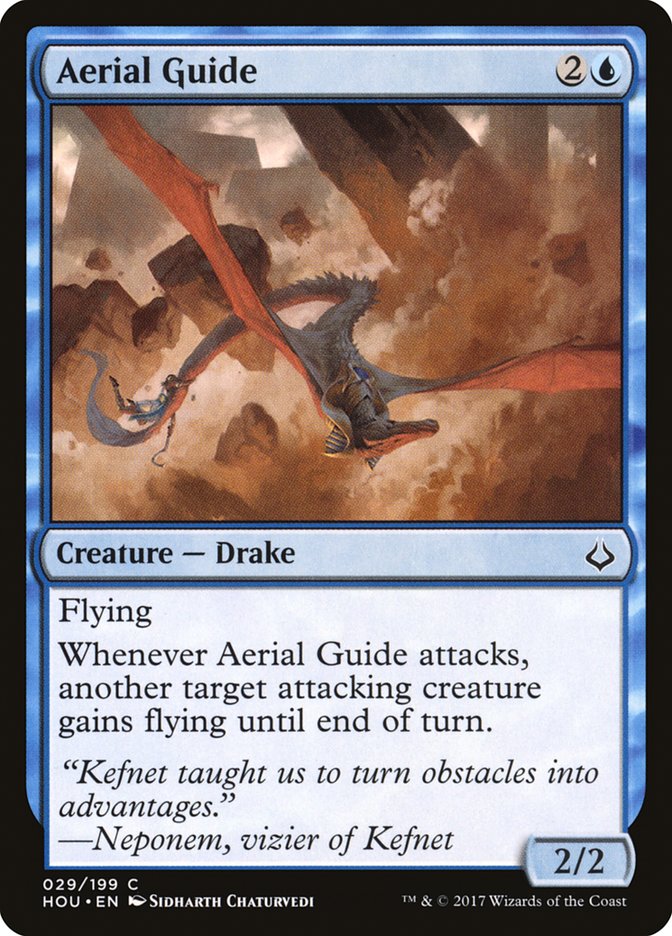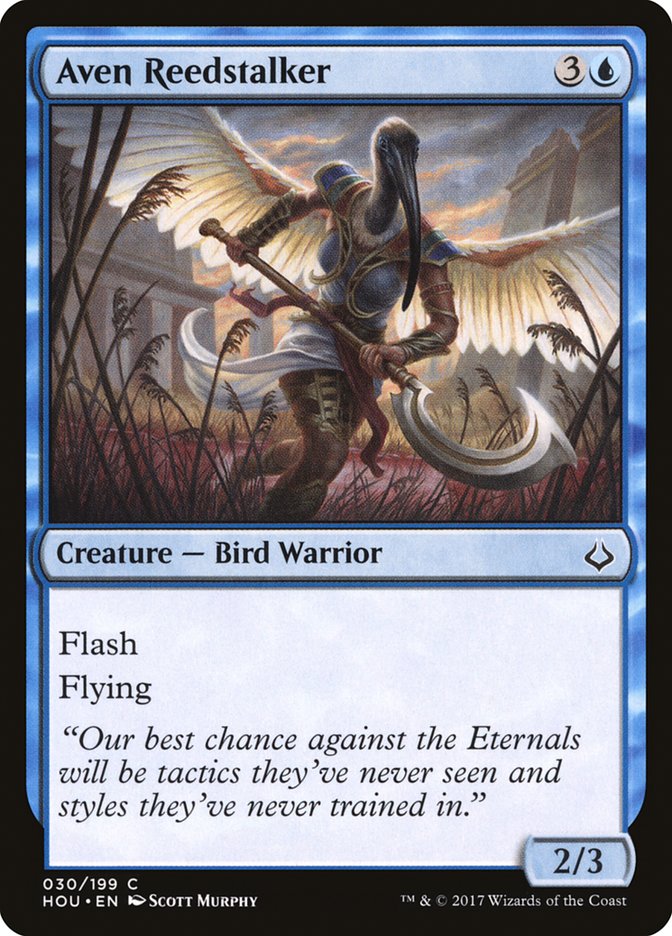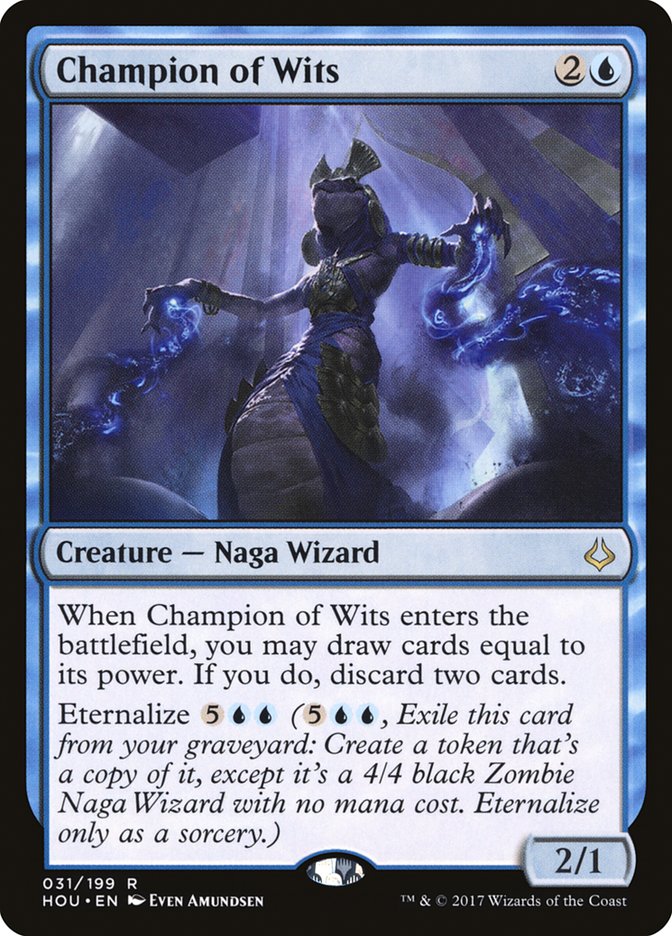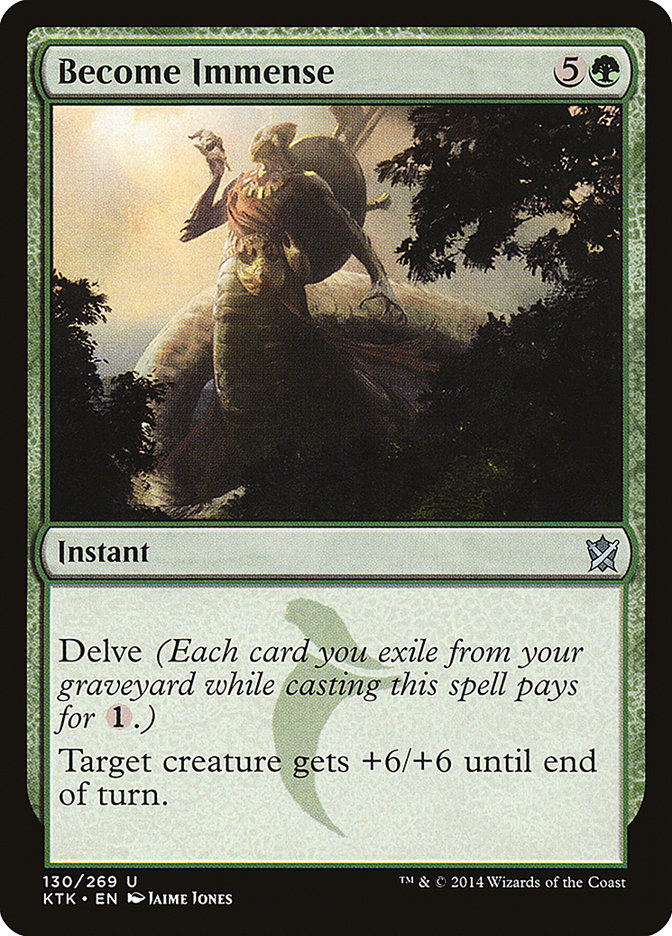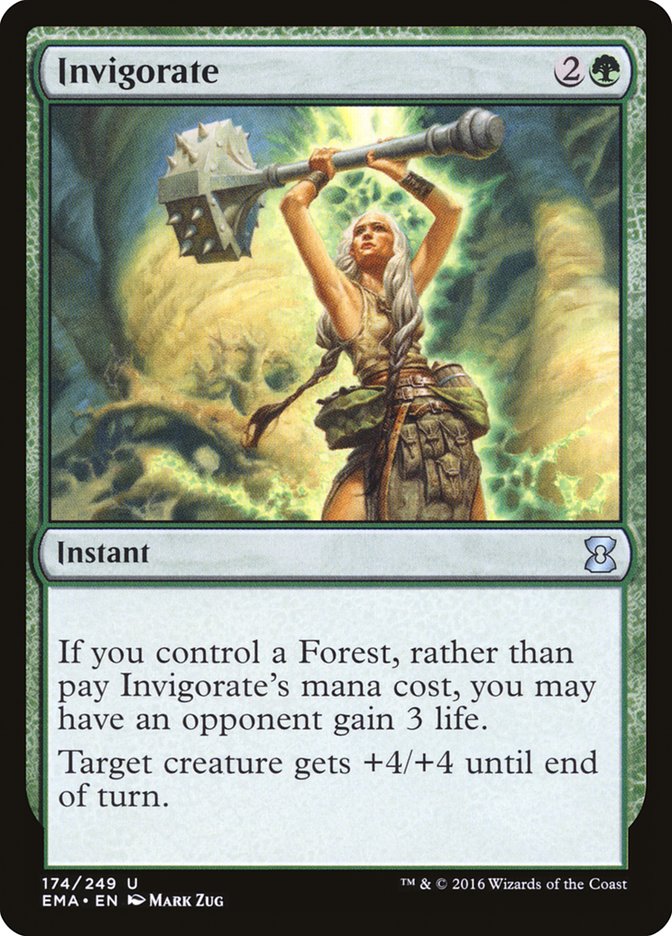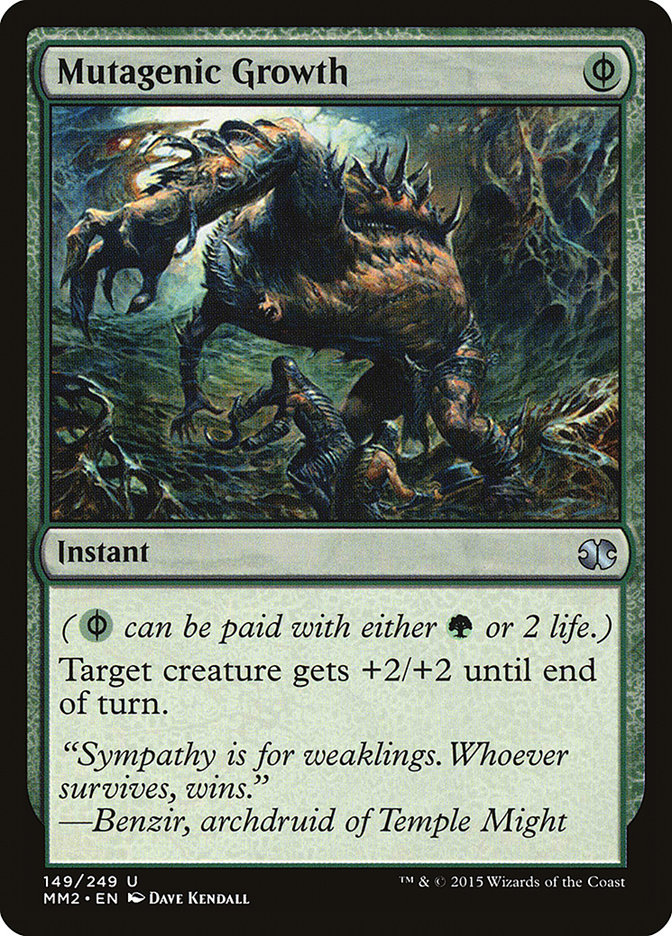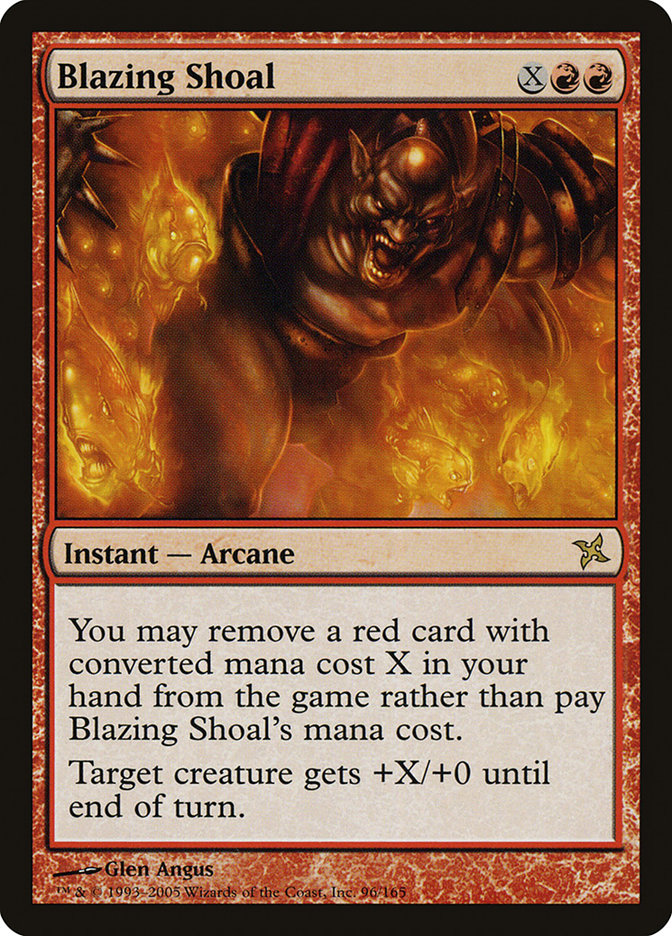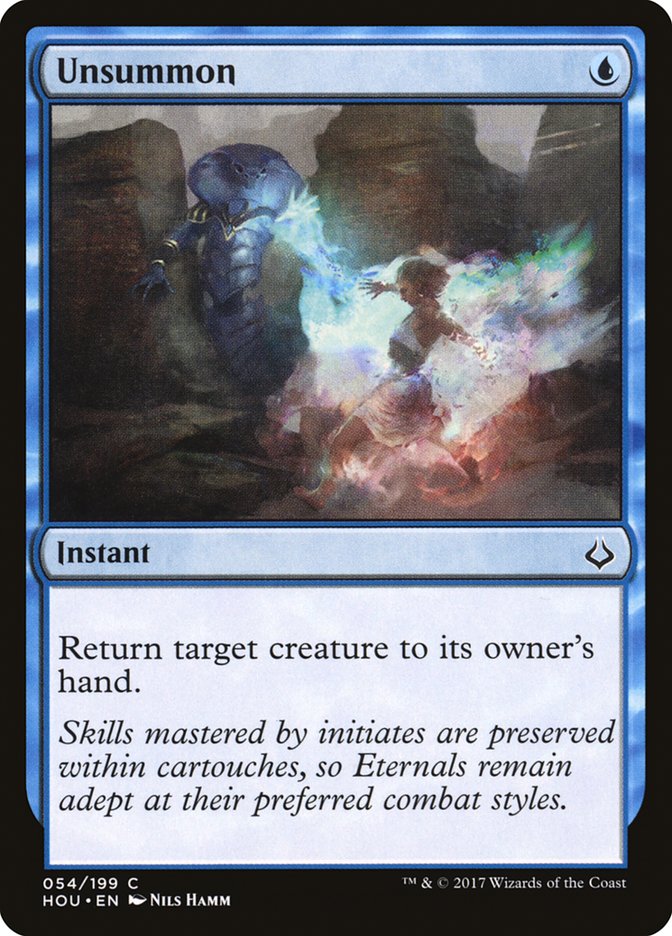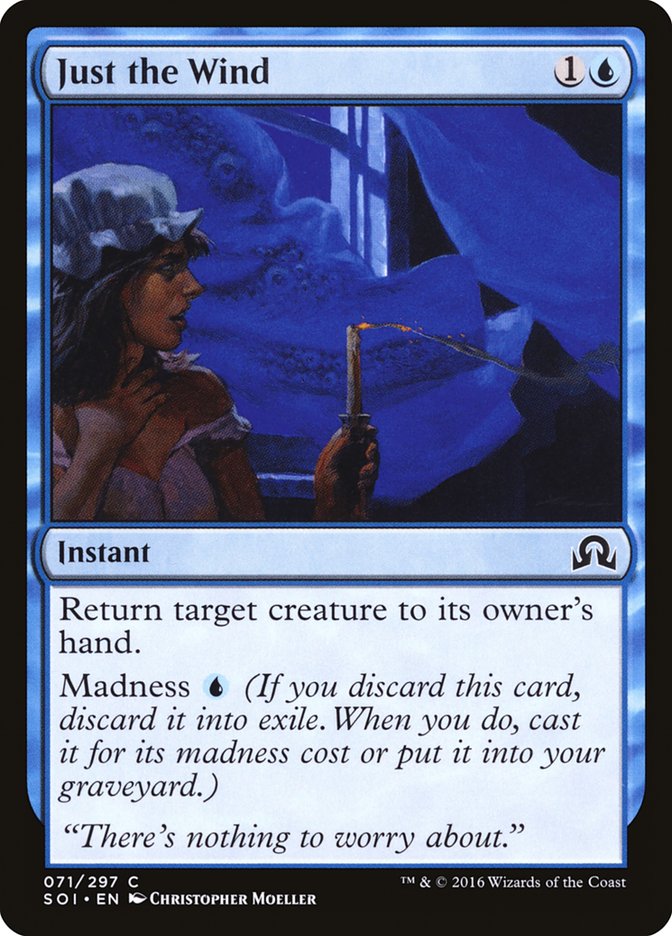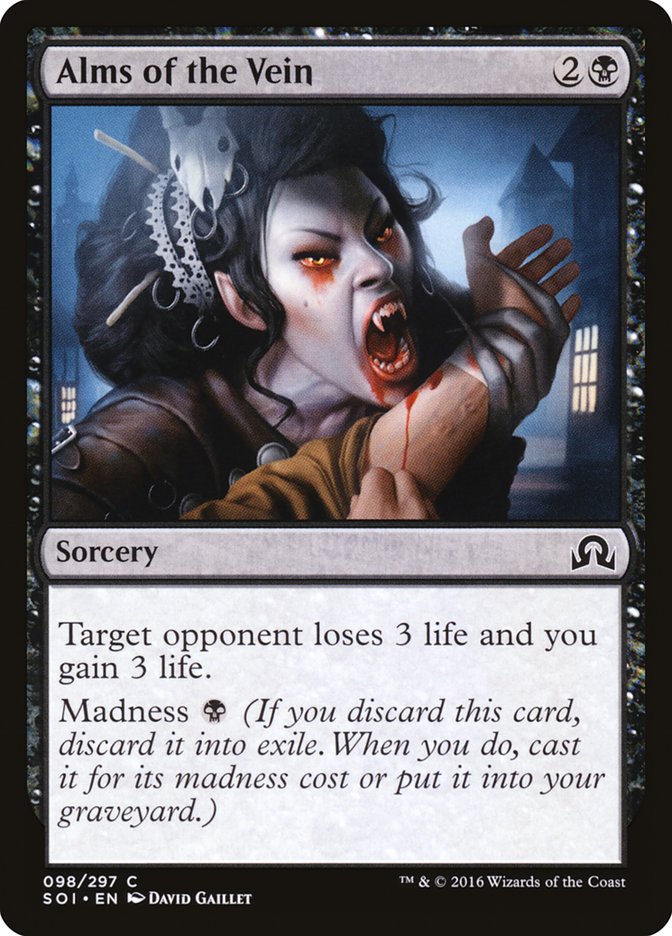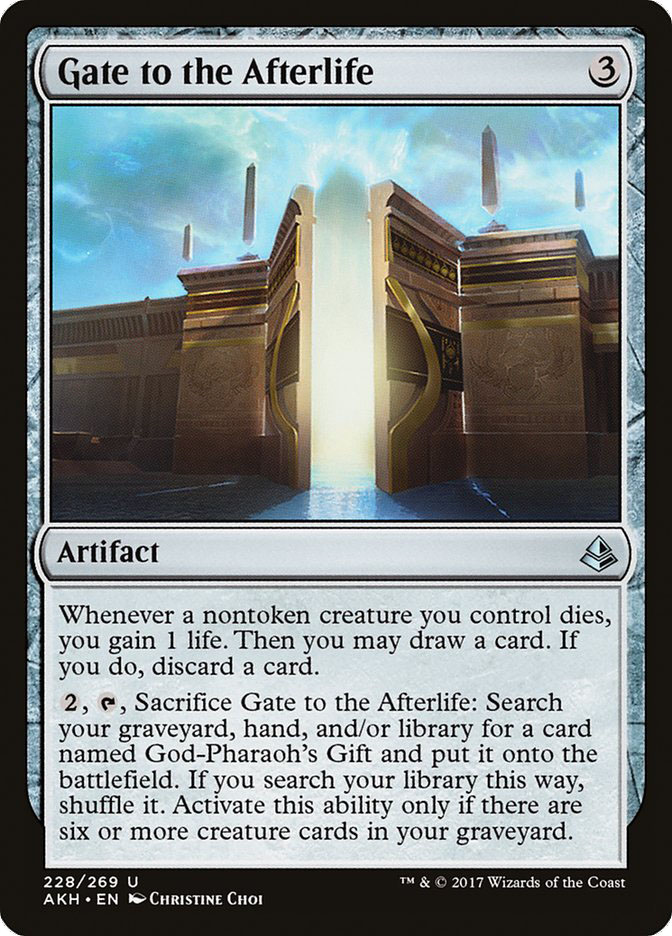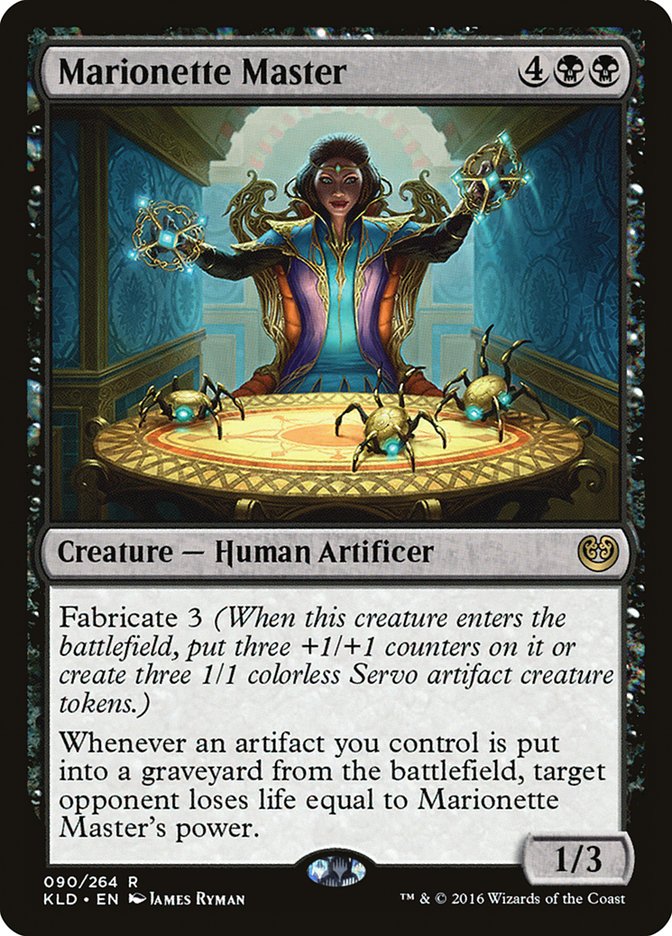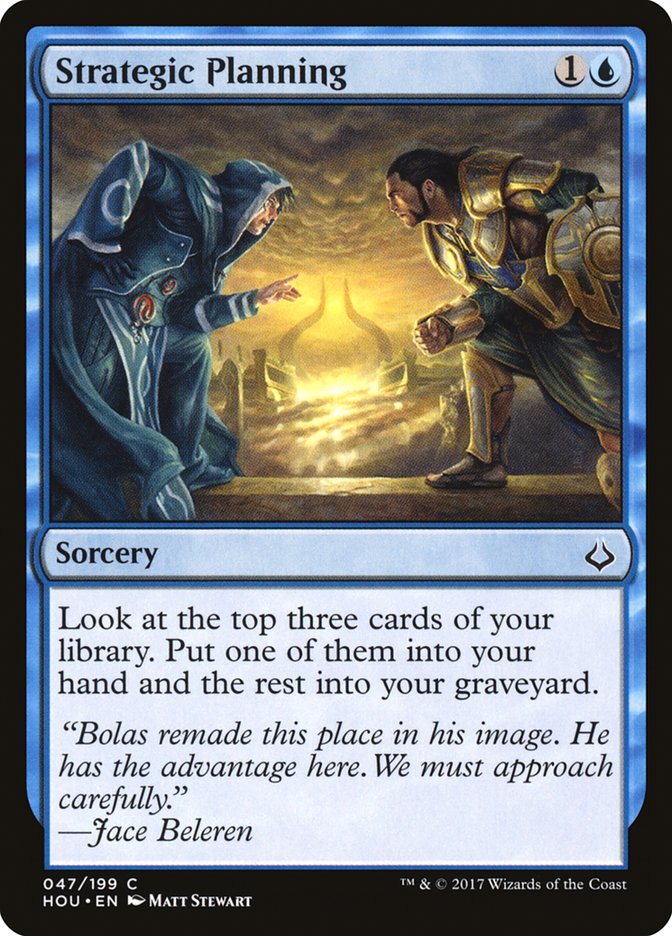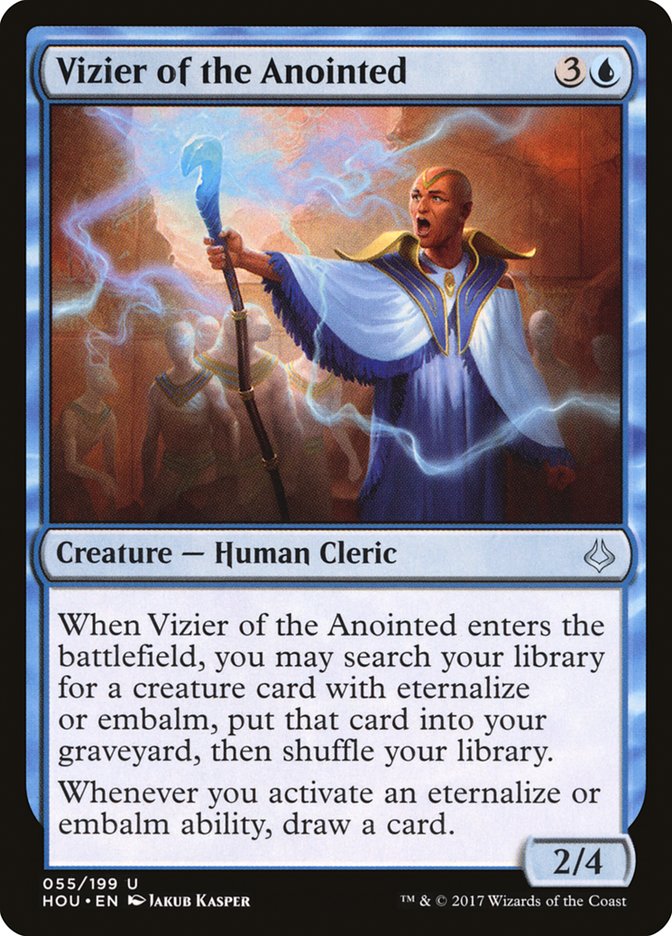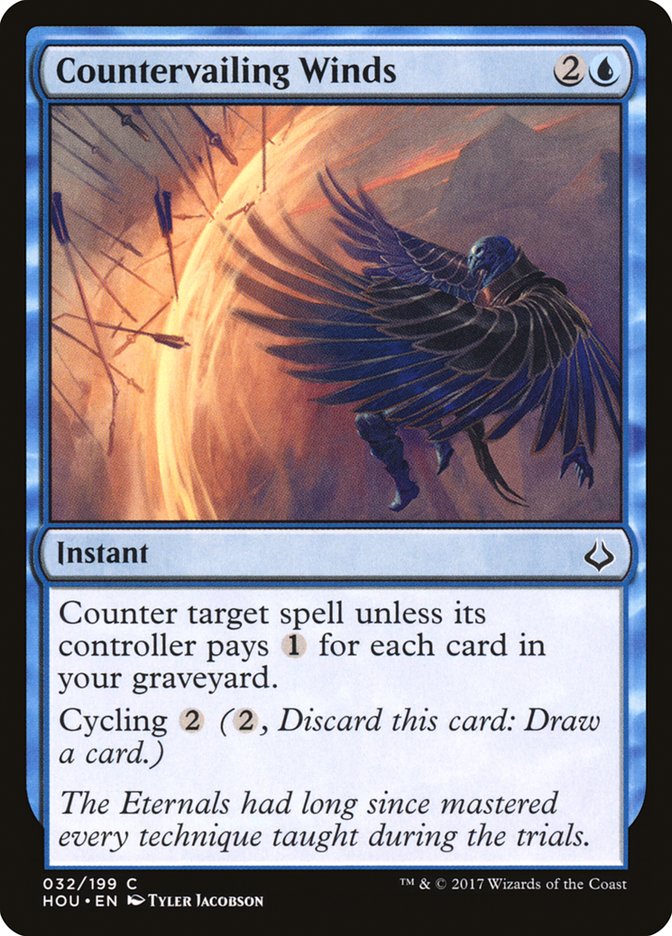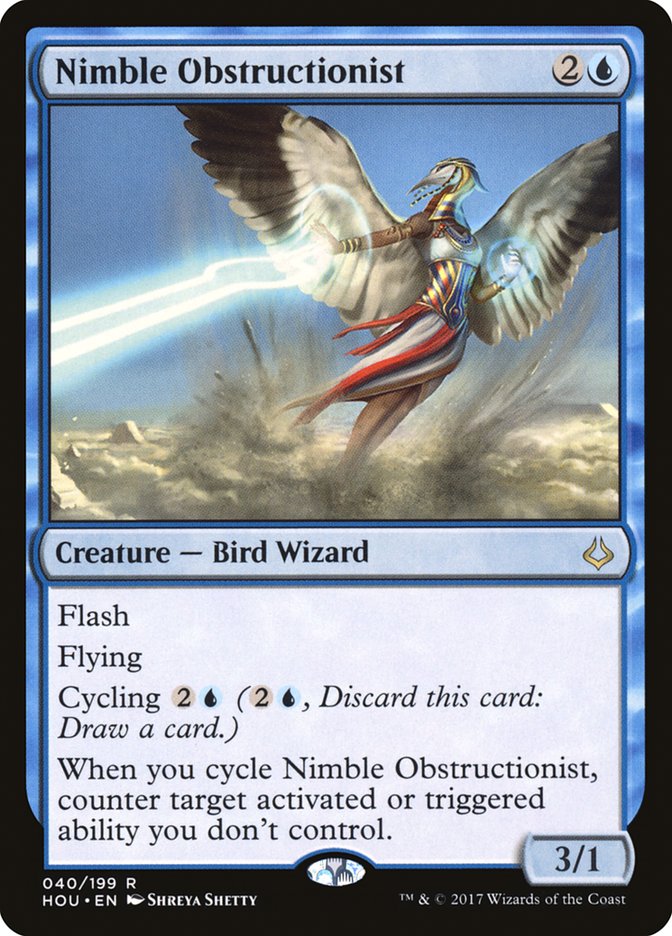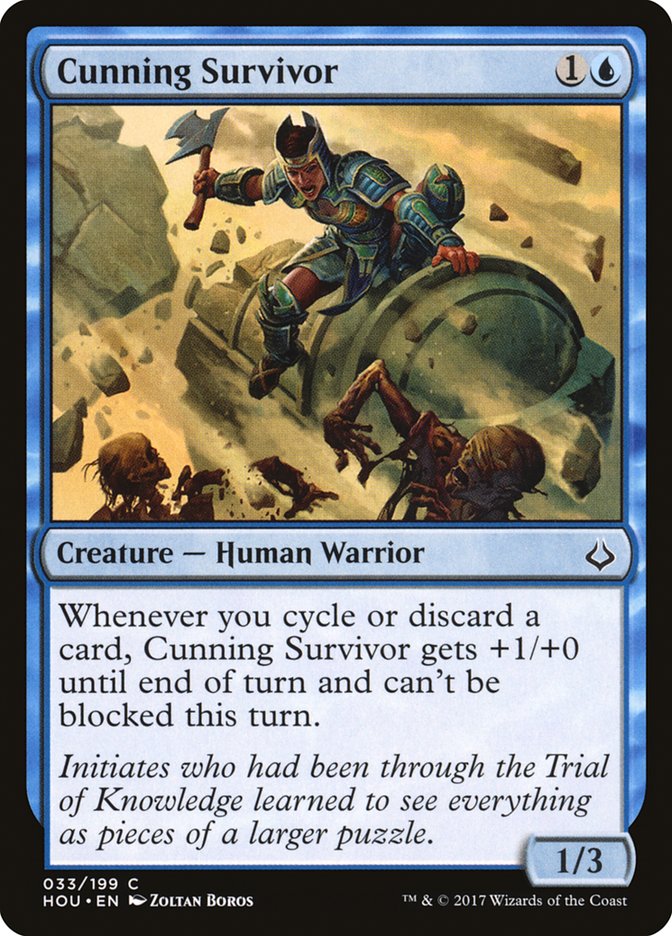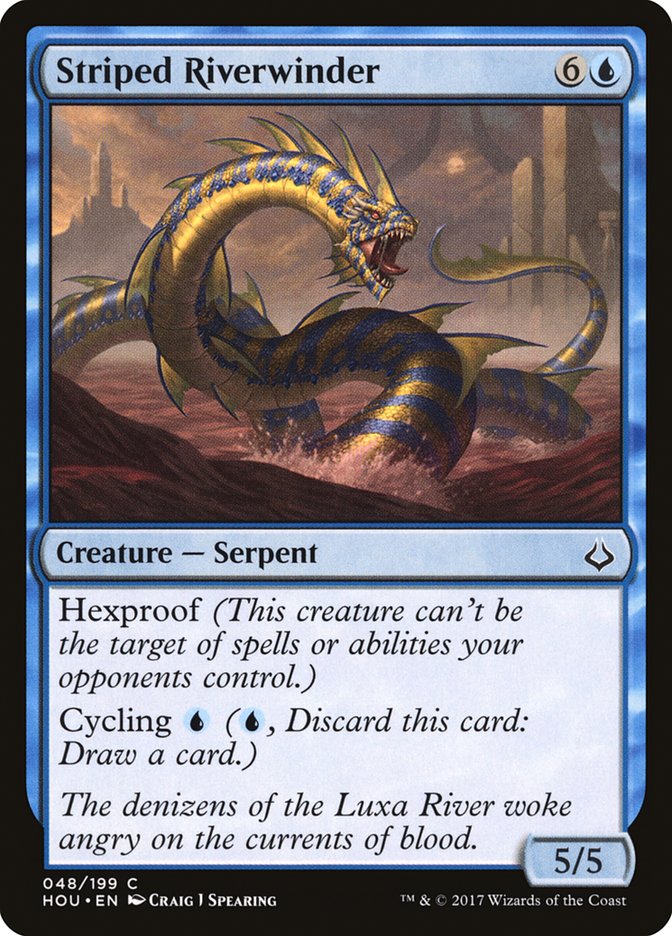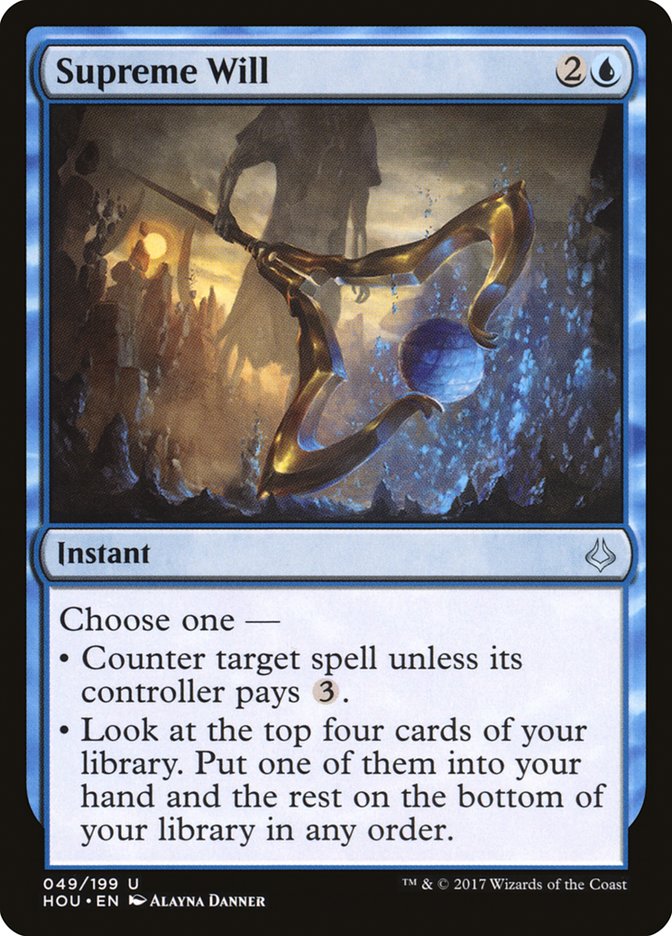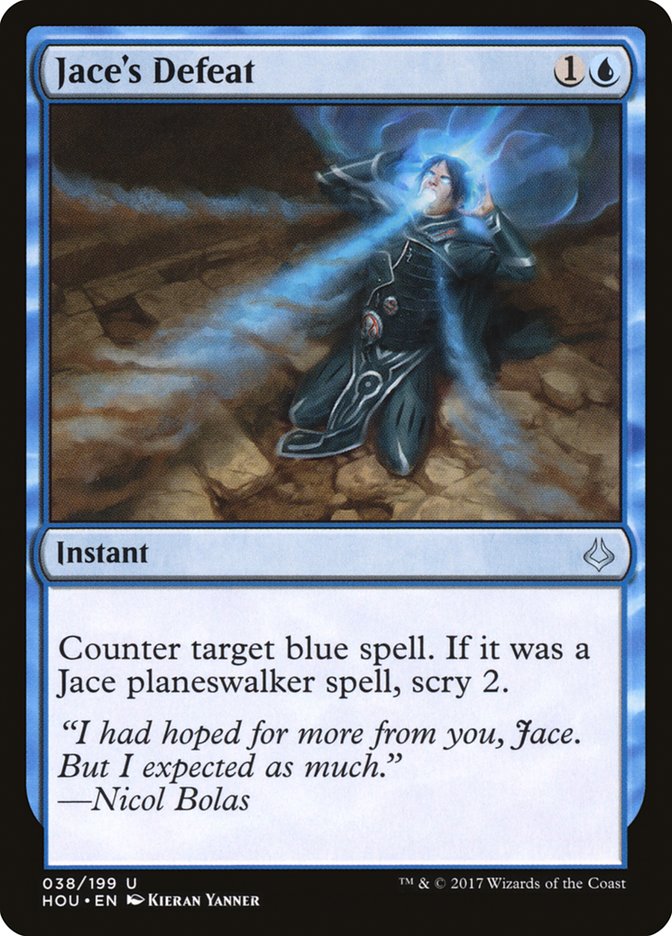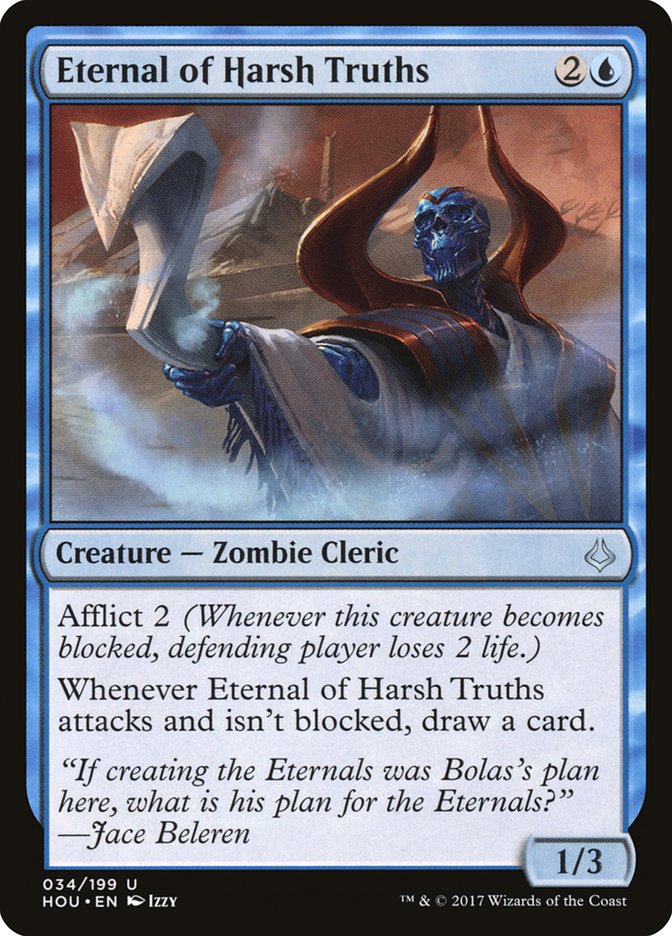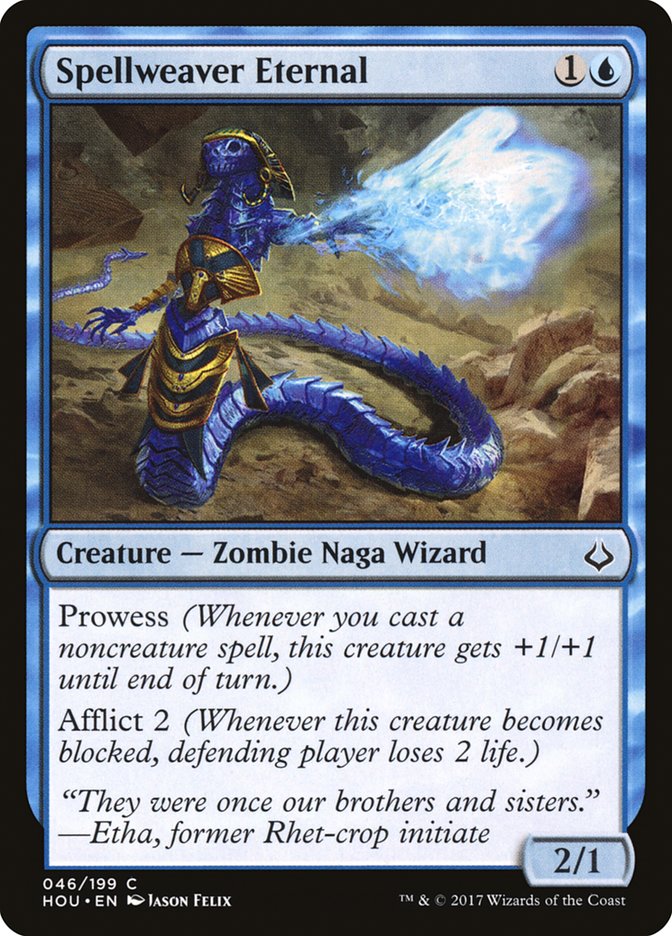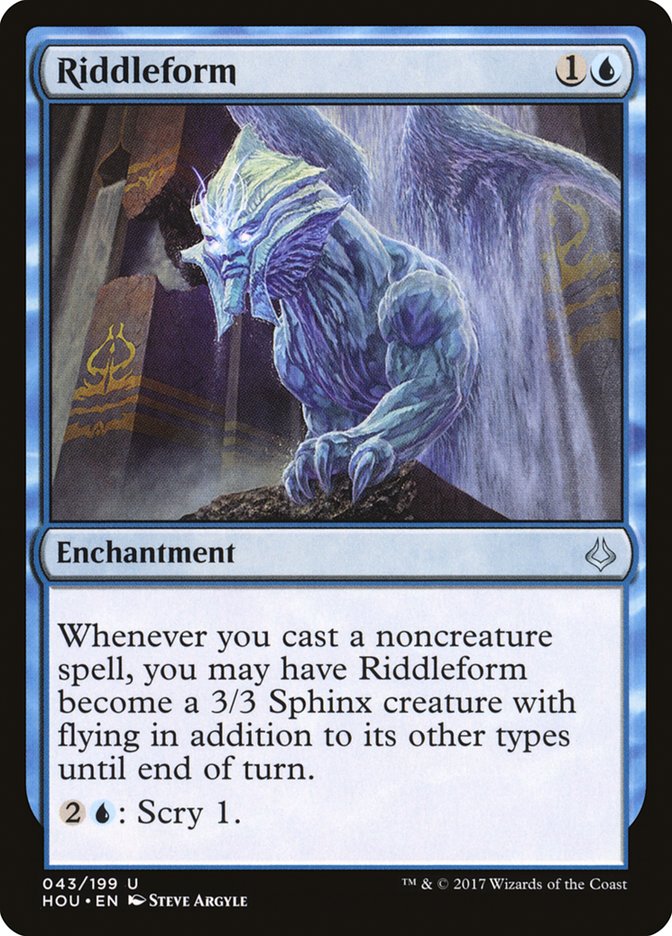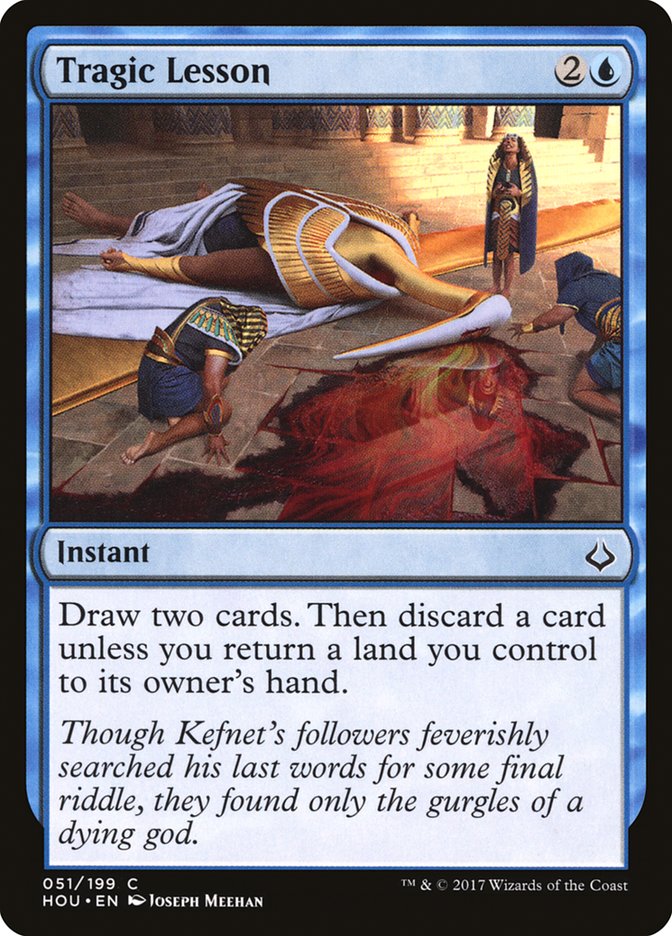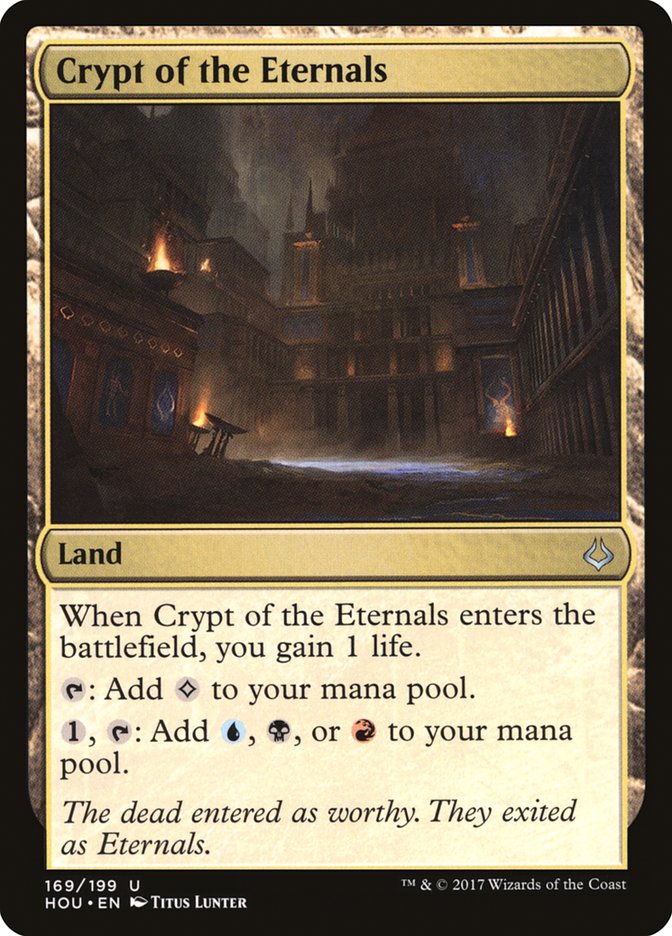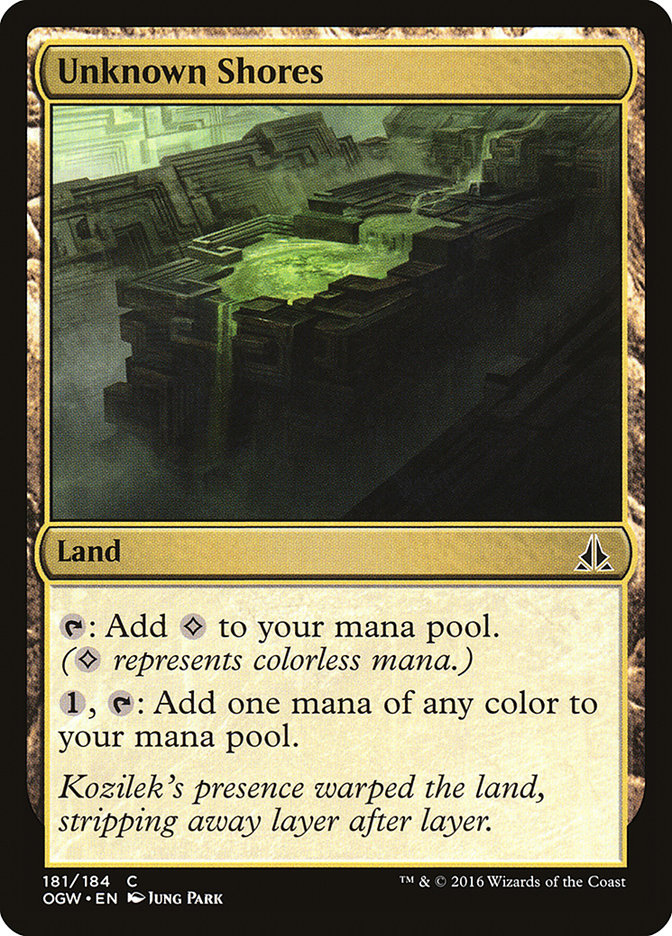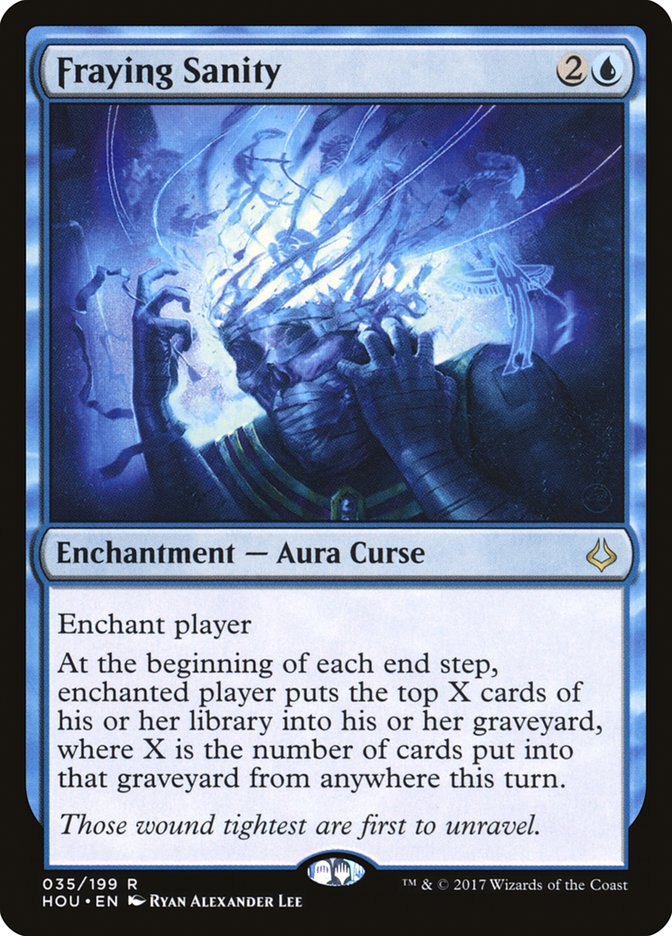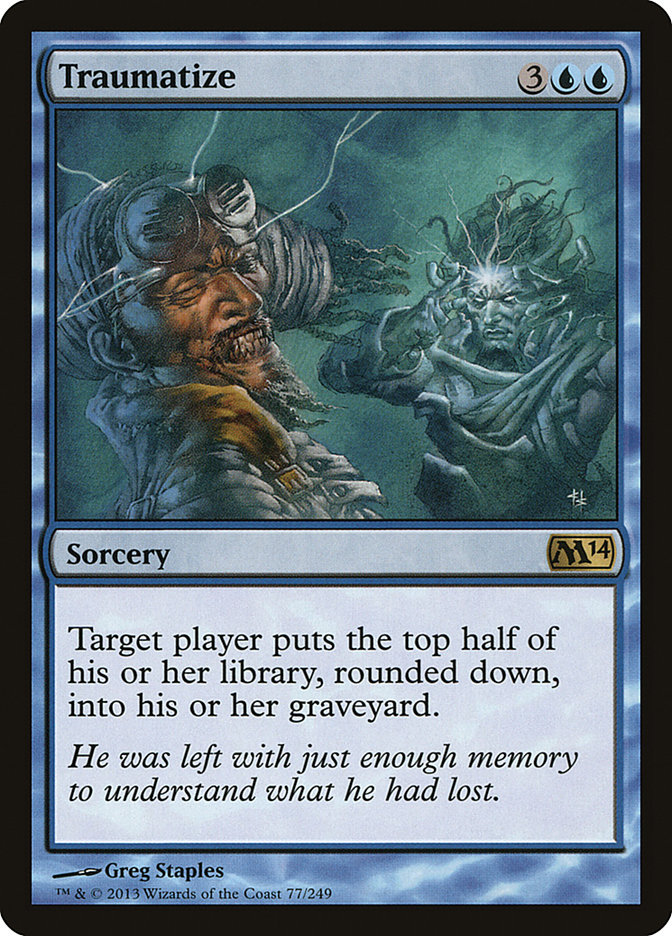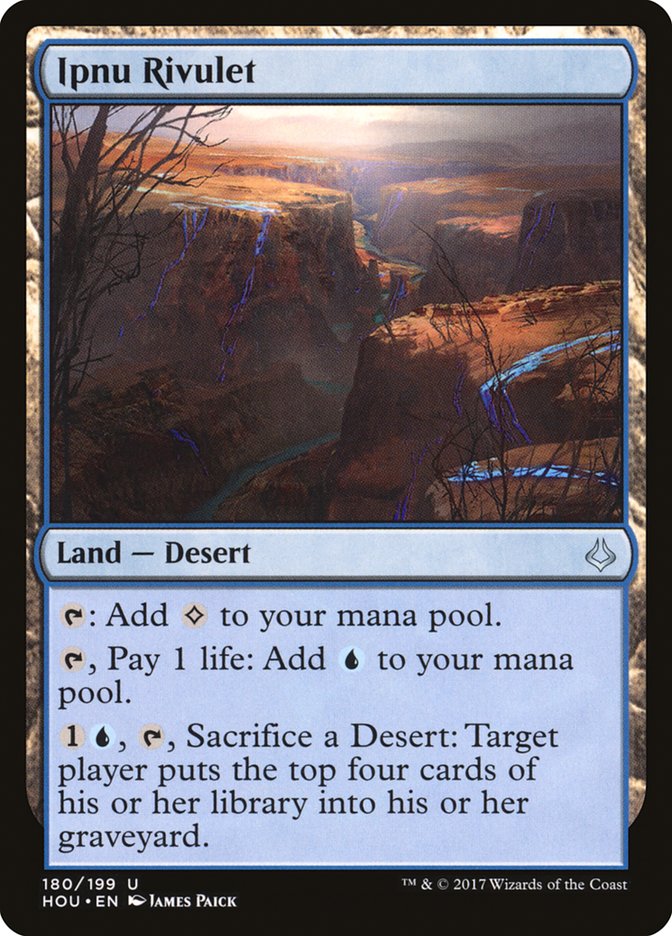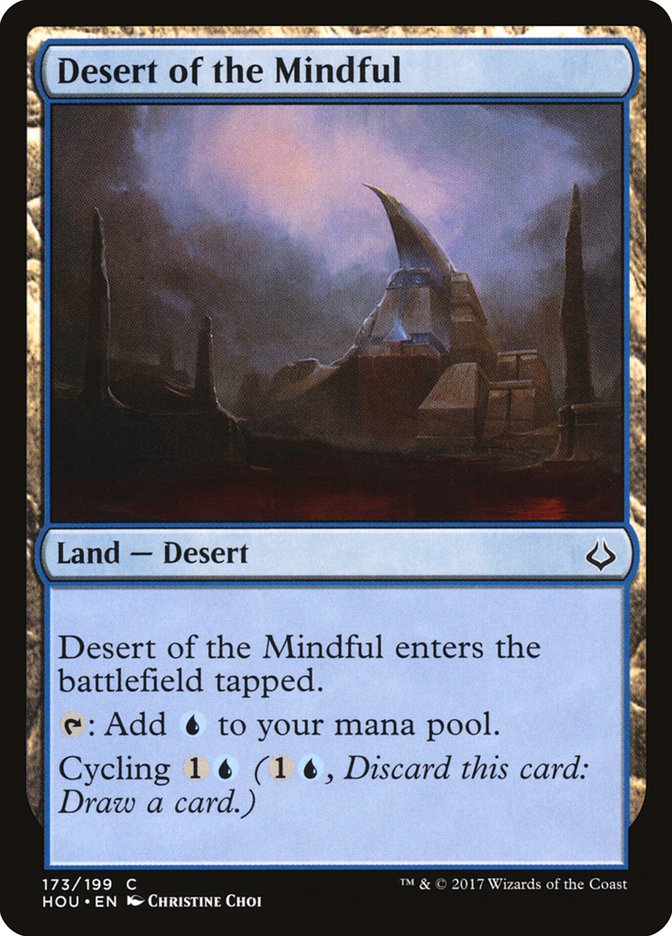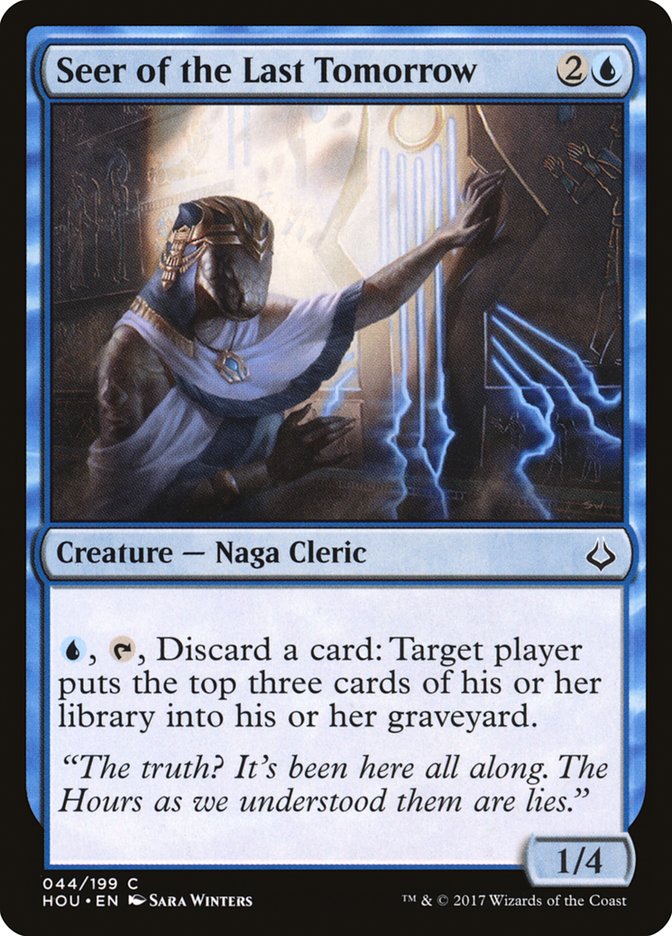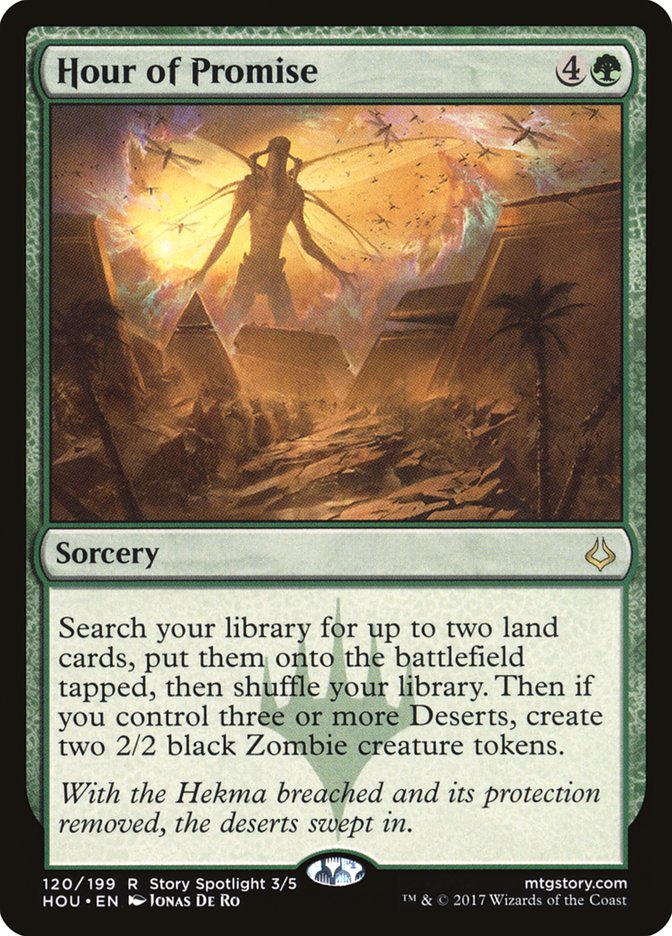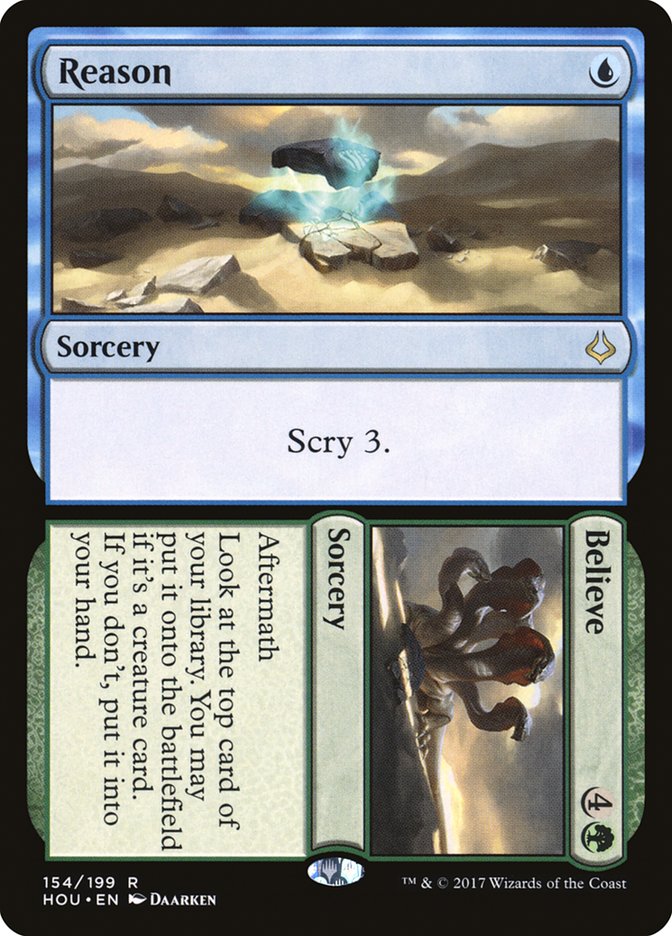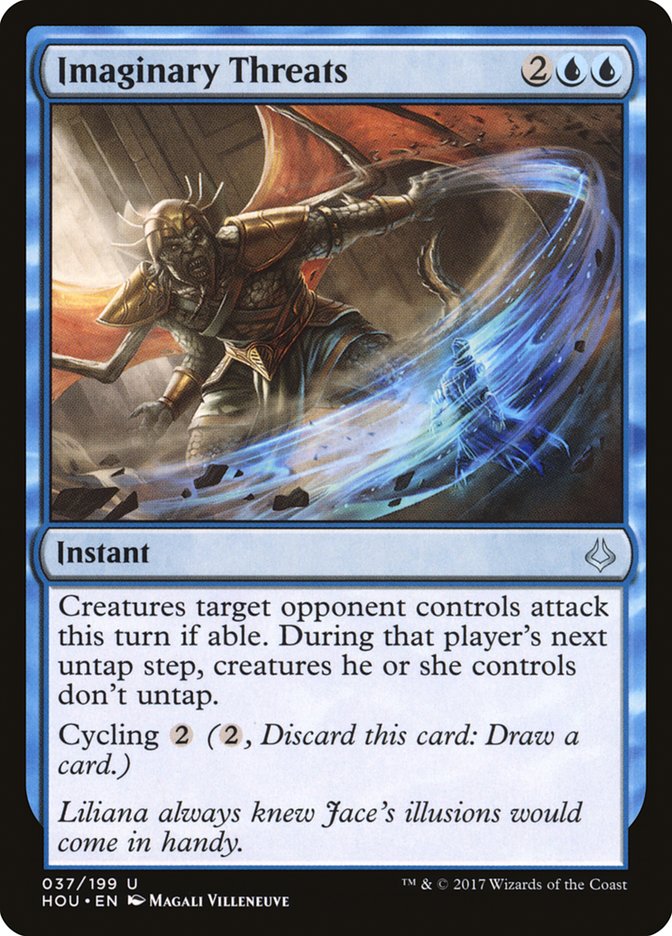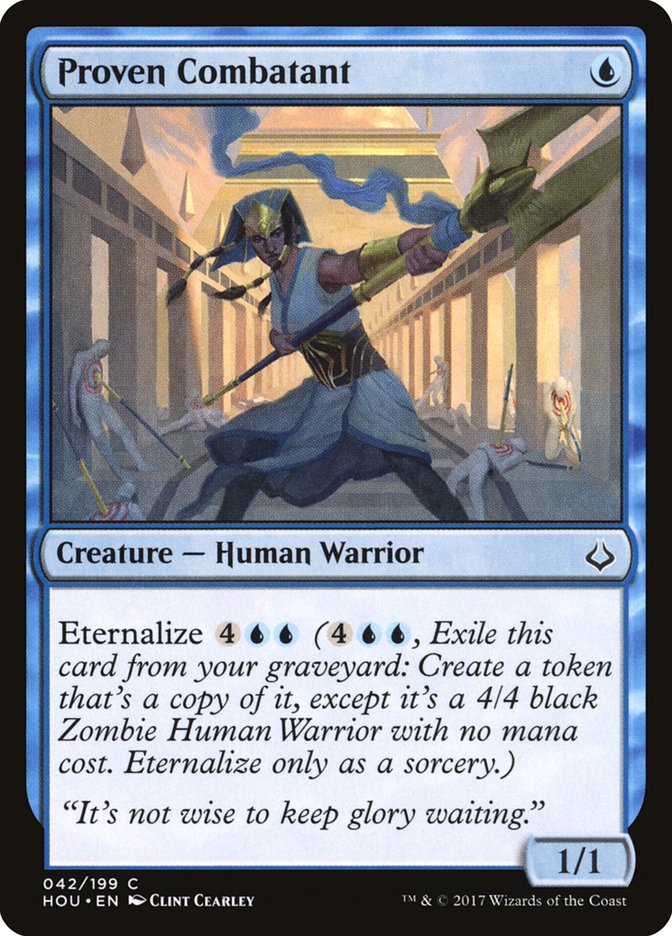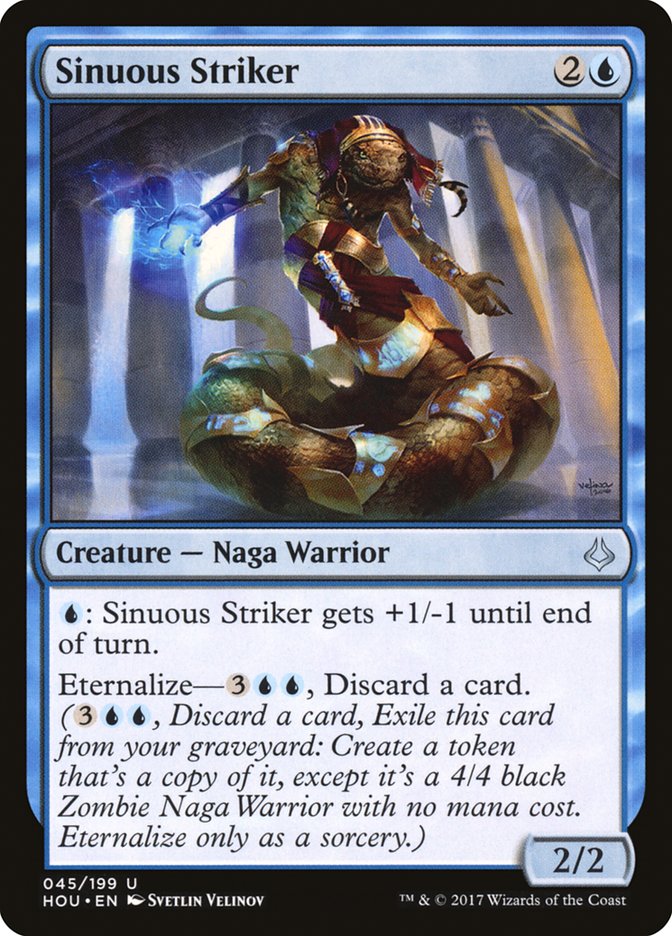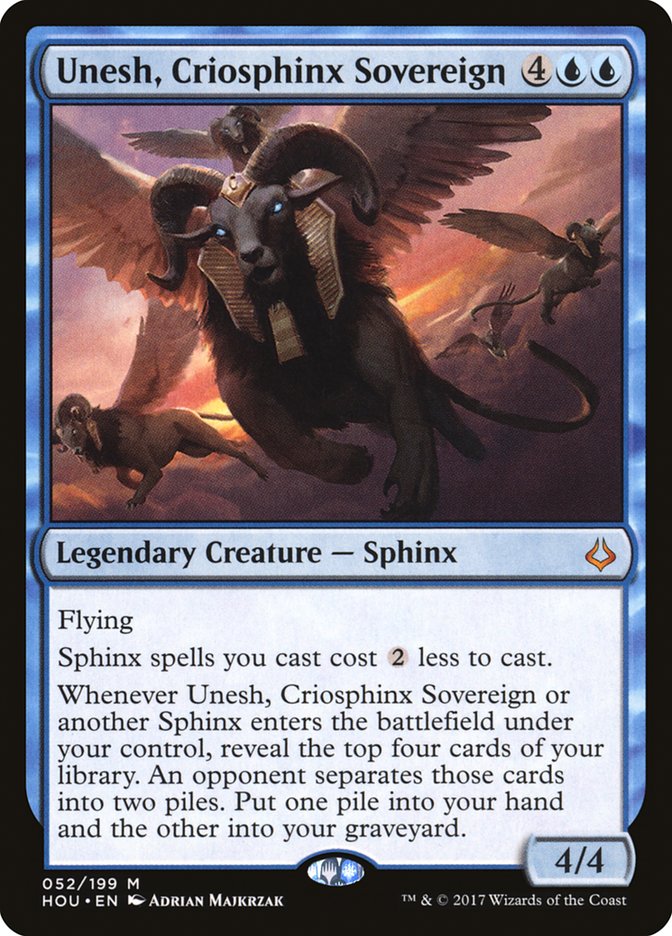Today, I’d like to take a look at the blue cards of Hour of Devastation. A look at the white cards can be found here. There’s a lot of ground to cover, so let’s dive right in.
While a slightly better rate than such cards usually are, we’re still not even remotely tempted for Constructed. Turn-after-turn abilities are inherently less valuable in Constructed than Draft, as bad things happen to creatures more frequently. Granting evasion is also less valuable in Constructed. Finally, just in terms of having stuff line up, a 2/2 for three has a lot of work to justify inclusion in this world of Magma Sprays.
While Aerial Guide might be merely a mana away from consideration, Aven Reedstalker would still have zero shot in Constructed.
Champion of Wits is one of the most interesting and potentially abusable cards in Hour of Devastation. It is also one of the most volatile. Here are my percentage predictions, where it has all of the following potential outcomes:
- 5% – Key part of a broken linear deck
- 10% – Key part of a legit Tier 1 strategy
- 10% – Key part of a Tier 1.5 strategy
- 75% – Flops despite so much promise
There’s a lot going on with Champion of Wits, so in trying to find the best home for it, we’ve got a number of competing aspects of the card to consider.
- It’s a very efficient source of looting. This makes it interesting to consider with all the usual looting synergies like madness, embalm, eternalize, reanimation, or other graveyard abilities.
- Its card draw scales with its power. This means Anthems like Always Watching equal extra cards, and cheap instant pump spells can be converted into extra cards.
- Its eternalize makes it a formidable threat for grinding the mid- and late-game.
- Like other enters-the-battlefield trigger creatures, it produces value up front and then leaves you with a body that can be sacrificed for value (which is especially nice if we can ever eternalize it).
In powered formats, there are lots of ways to potentially abuse the scaling on strength pretty hard. For instance:
Creatures (12)
Lands (18)
Spells (30)
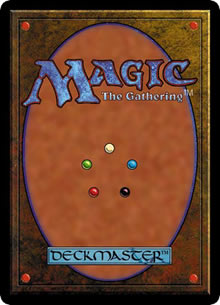
Become Immense is pretty intense on a Champion of Wits, and even just discarding cards to Champion of Wits can help turn Become Immense on earlier.
Mutagenic Growth and Invigorate are also pretty hot, especially when you consider how interested we were in playing them before Champion of Wits even entered the equation.
Blazing Shoal already had some quick combo kills with infect or double strike creatures. Now it can be used to turn Champion of Wits into a Griselbrand of sorts. Here’s a first stab:
Creatures (13)
Lands (18)
Spells (29)

As far as uncastable nine- or ten-cost red cards go, Progenitus is much more flexible than most. It can be part of a Natural Order combo or pitched to Force of Will. Even if we get stuck with both in hand, we can get one back into our deck for Natural Order, thanks to Champion of Wits.
As for Standard Champion of Wits applications, let’s try it as a source of looting and potential sacrifice fodder:
Creatures (30)
- 4 Prized Amalgam
- 2 Wretched Gryff
- 4 Elder Deep-Fiend
- 4 Haunted Dead
- 4 Cryptbreaker
- 4 Scrapheap Scrounger
- 4 Dread Wanderer
- 4 Champion of Wits
Lands (23)
Spells (7)

Champion of Wits is a pretty efficient creature to sacrifice to Elder Deep-Fiend and Wretched Gryff. Scrapheap Scrounger, Prized Amalgam, and Haunted Dead really needed another discard outlet to help make up for the lack of Smuggler’s Copter.
Unsummon is an exciting addition for ultra-tempo decks with good enters-the-battlefield triggers. The ability to make two good plays in the same turn can be big, and Unsummon costing a mana less than other options makes it substantially easier to bounce an Elder Deep-Fiend and recast it in the same turn. Even just bouncing Champion of Wits can be respectable, and the printing of eternalize and Rhonas’s Last Stand might lead to an increase in big token-making (which Unsummon is very efficient against, of course).
So, why Just the Wind?
I guess I just want to make sure we’re not overlooking a potential elevation of the card’s power. Champion of Wits gives us another discard outlet for the card, and maybe Hour of Devastation makes bounce enough better and Just the Wind proves actually competitive with Unsummon.
I haven’t forgotten about Compelling Deterrence, either. All these Zombies mean we’ve got great chances of kicking it, too. The problem is that we’re extremely focused on winning the tempo battle, stranding extra cards in their hand they never have time to cast. Them discarding one is going to be irrelevant a disproportionate amount of the time.
Depending on how turbo-discard outlet we get, Alms of the Vein is another underrated card to keep in mind that could gain a lot from the number of good discard outlets going from “not enough” to “enough.”
Supernatural Stamina might just be too cute, but it does a couple of cool things here. First of all, we can target our Champion of Wits in response to its trigger, letting us cash it in for two cards. That kind of directly contradicts what we were just saying about tempo versus card advantage, so we shouldn’t value this exchange as much as we might other places. That said, it is still an option, so if we end up valuing the ability to use Supernatural Stamina with Elder Deep-Fiend and Wretched Gryff, or just as a combat trick.
We don’t really have any other sacrifice outlets here, but if we played a version with Voldaren Pariah; Yahenni, Undying Partisan; Bone Splinters; or some such, we might be able to get extra mileage out of Supernatural Stamina on our Champion of Wits in response to its trigger.
If we do pick up more sacrifice outlets, Gate to the Afterlife is a very attractive payoff that further fuels our looting aspirations. What’s more, getting to tutor up and cheat onto the battlefield a single copy of God-Pharaoh’s Gift is a very powerful gameplan hitting from a different angle from some of our other stuff. We’ve even got some really cool combos with the God-Pharaoh’s Gift, such as Champion of Wits, which loves being a 4/4 when deployed.
Marionette Master is another potential payoff for lots of sacrificing, particularly if we’ve got ways to cheat it onto the battlefield, such as Liliana, Death’s Majesty, after discarding it to Champion of Wits. Once we’ve got God-Pharaoh’s Gift or The Scarab God active, we can make the Marionette Master a 4/4 and still get three Servos to sacrifice to whatever our sacrifice outlet is, each dealing four.
The Scarab God has some cool synergies, but just playing a 5/5 for five that dies to our hand is already some fairly serious midrange power. On top of that, we get a pretty respectable bonus for each of our Zombies, whether “natural” or from The Scarab God. The Scarab God can target opponents’ graveyards, making it a form of interaction against Scrapheap Scrounger and Liliana, Death’s Majesty. Finally, just activating its semi-eternalize ability each turn has a massive impact on the battlefield. It’s like we’re paying five to draw a card, but instead of a random card in our hand, it’s a zero-mana 4/4 with keywords and potential enters-the-battlefield triggers. Generally speaking, that’s better than drawing two cards.
Here’s an attempt to put The Scarab God into practice:
Creatures (18)
- 4 Sylvan Advocate
- 2 Tireless Tracker
- 2 Ishkanah, Grafwidow
- 4 Grim Flayer
- 1 Gonti, Lord of Luxury
- 1 Verdurous Gearhulk
- 2 The Scarab God
- 2 Champion of Wits
Planeswalkers (2)
Lands (23)
Spells (17)

I’m not sure The Scarab God needs to be in a Delirium deck, but it does help for making sure there’s food, and for getting both Ishkanah, Grafwidow (great combo with The Scarab God) and Traverse the Ulvenwald (for making one or two The Scarab Gods go a lot further).
It is kind of cute that Champion of Wits enables delirium, making it easier for a turn 5 Ishkanah to be active. Besides, Delirium decks are frequently better than average at dragging the game out long enough to get up to seven mana. Any Champion of Wits we flip to Vessel of Nascency or either Liliana can then be converted into a pretty substantial burst of card draw (not to mention an extra threat on the battlefield).
Consign // Oblivion is a very versatile piece of interaction that can also target our own enters-the-battlefield trigger creatures before eventually replaying them for value. Getting to eventually aftermath Oblivion can be a great way to win an attrition war, but Oblivion’s presence on the card at all starts helping us immediately, since it makes the card count as both an instant and a sorcery in our graveyard for the purposes of enabling delirium.
Strategic Planning is proving a tough nut to crack. It’s not that it’s hard to find a place to use it. You could just use it wherever, and it probably wouldn’t be too bad. It’s just that there are so many options for library manipulation, it’s hard to know where it’s right compared to the other options.
You want to take advantage of the selection, but most of the natural strategies that can do that don’t want sorcery-speed digging. You want to take advantage of the graveyard synergies, but most of the payoffs there are for aggressive decks that don’t want to take time off to dig. If you’re playing red, it’s generally just much weaker than Cathartic Reunion (except in the case of Cathartic Reunion getting countered).
Another possible way to put Champion of Wits to use is in some kind of dedicated Vizier of the Anointed deck. It’s not so much that we want to search up Champion of Wits. Most of the time, we’re probably just going to want to go get Honored Hydra or Vizier of Many Faces. Rather, the cards that work with Vizier of the Anointed tend to work well with Champion of Wits. For instance:
Creatures (29)
- 4 Hooded Hydra
- 4 Noose Constrictor
- 4 Rogue Refiner
- 4 Channeler Initiate
- 1 Vizier of Many Faces
- 4 Resilient Khenra
- 4 Champion of Wits
- 4 Vizier of the Anointed
Lands (23)
Spells (8)

Vizier of the Anointed is kind of a draw-three, when you think about it. One of the cards is a four-cost 6/6 and one card is a zero-mana 2/4 that draws you a third card if it lives even a single turn (with the potential to draw even more over time).
Eh. Maybe it’s just me, but this just seems like a lot of work. If we aren’t capitalizing on the copy aspect, but rather just getting 4/4s, we’re talking five mana for a 4/4, seven mana for two 4/4s, and nine mana for three 4/4s. That’s just not nearly as good as alternatives.
Once we’re copying the abilities (and getting creatures in our graveyard with abilities worth going to the trouble for), where is the point where this is better than Liliana, Death’s Majesty? Now, is that really better than doing the same thing with God-Pharaoh’s Gift or The Scarab God?
Countervailing Winds is pretty mediocre when compared to options like Disallow and Supreme Will. Nevertheless, it’s still got some cycling-related purposes, plus maybe it can occasionally show up in small numbers in regular control decks.
Creatures (18)
Lands (23)
Spells (19)

Vile Manifestation and Hollow One give us two fast, efficient, and aggressive threats to reward us for our devotion to the cycling mechanic.
An in-depth discussion of these two cards can be found here. Suffice it to say they usually produce a lot more body than their cost once we’re going to the trouble of playing so much cycling.
I’m not sold on how big of a role Countervailing Winds is supposed to play, however. What if we just didn’t play a worse Disallow?
I can’t say enough good things about this card. It just looks so good to me. Maybe I’m thinking too fancy, but every time I think of cantrip-fizzling a planeswalker ability or flashing down to kill one outright, I feel a little warm and fuzzy inside. For how devastating this card can be and how novel its options are, it sure has a great rate and a high floor.
In addition to planeswalkers, here are a few Nimble Obstructionist uses:
- Cycling
- Embalm or eternalize
- Madness
- Energy
- Evolving Wilds
- Eldrazi or Gearhulk triggers
- Archangel Avacyn
- Ishkanah, Grafwidow
- Cast Out and Stasis Snare
- Spell Queller
- Liliana’s Mastery
You can even counter your opponent’s Champion of Wits trigger!
Here’s another attempt at dedicated cycling, but with more of a beatdown angle:
Creatures (22)
- 4 Curator of Mysteries
- 4 Shadowstorm Vizier
- 2 Nimble Obstructionist
- 4 Hollow One
- 4 Cunning Survivor
- 4 Vile Manifestation
Lands (23)
Spells (15)

This list tries to really amp up the undercosted beatdown, using both Cunning Survivor and Shadowstorm Vizier.
Cunning Survivor means we have access to eight two-cost threats with evasion that scale with our cycling. Still, I don’t know why we’re working so hard, especially when neither the Survivor nor Vizier has cycling itself. One extra damage per card isn’t exactly the best multiplier ever, and being so reliant on tapping out on turn 3 makes it harder to use Nimble Obstructionist.
I think Nimble Obstructionist has a lot of potential applications in “normal” decks, too. That’s most of where I think it’ll show up, actually. For instance, in this U/B Control deck, it helps make Liliana, the Last Hope a lot more playable:
Creatures (7)
Planeswalkers (2)
Lands (25)
Spells (25)

Normally, decks like this don’t always have good ways to get creatures into the graveyard reliably enough. Now, however, you can surprise your opponent with a Nimble Obstruction cycle, untap, drop Liliana, use her -2, and get an extra card on a turn where she’s safe from immediate counterattack.
If we want even more creatures for our graveyard, Striped Riverwinder is a respectable option.
Curator of Mysteries was already getting used for this occasionally, and while Striped Riverwinder has an objectively worse rate, a 5/5 hexproof might be enough better when we don’t cycle it to be worth the substantial mana premium. By that late in the game, we might just have plenty of mana anyway.
Supreme Will is a great new option for control decks and the one-two punch of Supreme Will and Nimble Obstructionist represents a major change to the ways blue decks can interact. I think you wanna be careful not to be too reliant on Supreme Will, as things will get awkward later in the game when you really want hard counters. I also think you need to have really dynamic cards worth Impulsing for. If your deck is super-homogenous, why spend the mana? What are you even looking for?
Nimble Obstructionist is an easy addition for any W/U Spirits decks we might be inclined to build, fighting alongside Spell Queller and Stasis Snare very nicely. For instance:
Creatures (24)
- 4 Archangel Avacyn
- 4 Thraben Inspector
- 4 Spell Queller
- 4 Selfless Spirit
- 4 Glory-Bound Initiate
- 4 Nimble Obstructionist
Planeswalkers (3)
Lands (24)
Spells (9)

Even though it’s not white, Nimble Obstructionist could find a home in the latest deck of the week, W/U Monument. For instance, here’s a list very close to the list GerryT talked about here.
Creatures (23)
- 4 Bygone Bishop
- 4 Thraben Inspector
- 2 Hanweir Militia Captain
- 4 Spell Queller
- 4 Selfless Spirit
- 4 Cloudblazer
- 1 Nimble Obstructionist
Lands (25)
Spells (12)

Obviously, Dusk // Dawn is awkward with Nimble Obstructionist, but I dunno, the heart wants what the heart wants.
I’m not sure the metagame is ready for overloading on Jace’s Defeats yet, but it’ll get there…
I would enjoy this creature being good, and it is a lot better than Ophidian, but these days, lots of cards are.
Here’s an attempt:
Creatures (17)
- 4 Stitched Mangler
- 3 Glorybringer
- 2 Nimble Obstructionist
- 4 Eternal of Harsh Truths
- 4 Spellweaver Eternal
Planeswalkers (2)
Lands (24)
Spells (17)

Lots of cool little synergies, seems like it’d be a lot of fun; sadly, probably just way too big a violation of the prime directive.
“Never play a bad something else.” – Michael J. Flores
Yeah, it’s cute getting to play Zombie synergies in a nonblack deck, and who wouldn’t want to re-live the Shadowmage Infiltrator / Ophidian glory days?
Probably more of a Draft card, but it’s not exactly the worst aggro threat. Probably worse than Riddleform, for the most part, but if we’re getting enough value from it being a Zombie, maybe that’s enough. I’m not sure powering up Compelling Deterrence is enough value.
Prowess threat that hits for three with only a single spell, has evasion, dodges sweepers and sorcery-speed removal. The scry 1 mana sink is a tiny, but useful option for when you’ve got nothing else to spend mana on. Even still, being better than Spellweaver Eternal is not necessarily enough to get a card into Constructed.
The above is more of a tempo deck than a burn deck, whereas Refuse // Cooperate is pretty solely burn-oriented. If we wanted to put Refuse // Cooperate to use, we might look to something like the following:
Creatures (9)
Lands (23)
Spells (28)

It’ll be interesting to see if Tragic Lesson ends up proving good enough in the more Burn-oriented lists or if it’ll be more of a mid-speed control card.
Remember, each Tragic Lesson could just be a Tormenting Voice or Cathartic Reunion, so we’ve got to justify that extra mana by taking advantage of it being an instant or actually picking up a land sometimes (or else, why go to the trouble?) It’s worth noting, you don’t have to decide whether to bounce a land or which one until after you see what you’re drawing.
Having some Tragic Lessons in your deck is kind of interesting with Wandering Fumarole, as it’s a really effective way to protect it in response to a Fatal Push. You can also get extra energy from Aether Hub or trigger any other enters-the-battlefield ability from your lands, such as Sunscorched Desert or Crypt of the Eternals.
Look, I wanna play Grixis as badly as the next person (assuming the next person isn’t Corey Burkhart), but if it ends up only possible because of an Unknown Shores that gains one life, well, I don’t know I want it that badly.
Okay, that’s a little harsh. Unknown Shores wasn’t exactly the perfect land for whatever Grixis deck we were thinking, but the extra life could add up, especially if we’re playing Tragic Lesson and Kefnet the Mindful. In particular, I could see one or two Crypt of the Eternals in a mostly two-color blue deck splashing the third color.
Fraying Sanity is the best dedicated mill enabler in a little while. In Modern, we can couple it with Traumatize for a two-card combo kill.
In Standard, it’s a bit of a struggle, but here’s an attempt. I have it on good authority that Tom Ross is in love with this card. Stay tuned on that…
Creatures (8)
Lands (22)
Spells (30)

In addition to copying Startled Awake, Vessel of Paramnesia, Manic Scribe, and Minister of Inquiries, we also pick up some Desert synergies, thanks to Ipnu Rivulet.
Ipnu Rivulet isn’t exactly hyper-strong or anything, but the opportunity cost is pretty low. We’re really not going to be taking much damage here, so all we’re really giving up is Engulf the Shore (which would also require us to pass on Aether Meltdown).
Draft only. Costs at least one too much (compare to Manic Scribe and Minister of Inquiries), and costs blue mana each turn to use (again, compare to Manic Scribe and Minister of Inquiries).
While I don’t think you have to be playing Deserts to make Hour of Promise work, it’s probably better too. This could potentially be another home for Ipnu Rivulet, maybe marrying the Hour into double Shrine of the Forsaken Gods into Ulamog sequence with Reason // Believe.
Reason // Believe starts off as mediocre library manipulation, sort of a poor person’s Contingency Plan. If we can find an awesome creature, we can arrange our affairs in such a way that when we aftermath Believe, we get to put that awesome creature onto the battlefield. We won’t get any Eldrazi when-played triggers, but maybe Ulamog is good enough anyway?
Creatures (18)
- 4 Ulamog, the Ceaseless Hunger
- 1 World Breaker
- 2 Tireless Tracker
- 1 Ulvenwald Hydra
- 1 Elder Deep-Fiend
- 4 Rogue Refiner
- 4 Walking Ballista
- 1 Vizier of the Menagerie
Planeswalkers (4)
Lands (23)
Spells (15)

There’s kind of a shortage of good fatties that completely take over a game when cheated onto the battlefield, but Razaketh, the Foulblooded might be enough, particularly if Liliana, Death’s Majesty can also be a vehicle for cheating it.
Draft only. This is just too expensive for how much work you gotta do to set this up in Constructed.
It’s kind of a less impressive Confiscation Coup. That said, it does have the added flexibility of stealing an enchantment.
Probably for Draft only, though maybe there’s some Embalmer’s Tools deck that can afford how expensive this embalm cost is.
Draft only. What novelty it brings in options can be acquired at a better rate elsewhere.
[SWARM INTELLIGENCE]
Too expensive and slow to get going.
Okay, so for starters, it’s a six-cost 4/4 flier that draws two cards with a little selection. That’s actually not bad. It’s kind of a Cloudblazer, though generally that extra mana is probably a little worse than +2/+2 and +2 life, especially when Dusk // Dawn is available.
Ok, what about the Sphinx tribal synergies?
Curator of Mysteries is pretty solid, but that’s a pretty sketchy supporting cast. If we go filling our deck with those types, we’re likely going to be mostly just flooded with mediocre five-drops. Maybe the way to do it is just play four Curator of Mysteries and call it a day. When we’ve got an Unesh, great, Curator of Mysteries is a two-mana 4/4 flier that draws us two cards. Awesome. When we don’t we cycle the Curator and move on with our lives.
Of course, the problem is that Unesh costs the same amount as Torrential Gearhulk.
This makes me think the best home is some kind of a deck that wouldn’t be able to use Torrential Gearhulk anyway. For instance, some kind of a U/G Eternalize/Embalm deck, like earlier, might be able to incorporate four Curator of Mysteries and two to three Unesh (perhaps with Hollow One?). Unesh being able to flip graveyard cards means we can turn its ability into even more than a draw-two. Also, just to be clear, getting your choice of piles is definitely meaningfully better than two random cards.
It’s a long shot, but not completely out of the question. The thing is, we aren’t really at risk of the supply of aggressively mediocre blue Auras that lock down a creature drying up, and this one isn’t anything special.
And that’s the blue situation. I’ll be back with more after the big debut weekend in Cincinnati!


